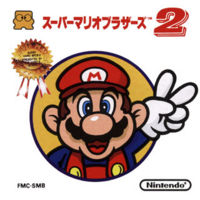Super Mario Bros. 2 (Japan)

| |
| Super Mario Bros. 2 | |
| Developer | Nintendo EAD |
| Publisher | Nintendo |
| System | NES (Famicom Disk System), Game Boy Advance, Virtual Console (Wii, 3DS, Wii U) |
| Release Date | NES JP June 13, 1986 Game Boy Advance JP August 10, 2004 Wii Virtual Console JP May 1, 2007 PAL September 14, 2007 US October 1, 2007 3DS Virtual Console JP July 25, 2012 US/PAL December 27, 2012 SK July 6, 2016 Wii U Virtual Console JP August 8, 2013 PAL January 23, 2014 US March 13, 2014 |
Super Mario Bros. 2 (known as The Lost Levels in most English releases) is the original Japanese sequel to Super Mario Bros. that was released as a part of the Famicom Disk System. The game was believed to be too hard for American gamers, so a different game called Super Mario Bros. 2 was developed for release in America and Europe from the Japanese game Yume Kōjō: Doki Doki Panic. The Japanese Super Mario Bros. 2 was later released internationally in several forms, starting with its inclusion in Super Mario All-Stars, where it was first dubbed "Super Mario Bros.: The Lost Levels" in order to differentiate it from the other Super Mario Bros. 2.
Information[edit]
The game is made from the same engine as the original Super Mario Bros., so the two share many similarities, from the graphics to the basic gameplay. However, The Lost Levels is designed to be much harder than the original game. New enemies include flying Bloopers, Piranha Plants that emerge from pipes even when the player is standing on them and additional clones of Bowser appearing in fortresses. There are also new obstacles such as Poison Mushrooms, springboards that propel the brothers offscreen, Warp Zones with pipes that can send the player backwards to previous worlds and winds that blow the brothers away. All enemies and power-ups from the first game also return.
The game also follows a similar format as the original Super Mario Bros.. One change is that The Lost Levels the player can choose to play as either Mario or Luigi, who are statistically different for the first time. The game also has nine worlds instead of the original's eight, although the ninth world can only be reached by beating the first eight worlds without Warp Zones. Four extra worlds, called Courses A-D can also be unlocked.
Legacy[edit]
Two notable elements of this game found their way into later titles. The first was the distinguishing of Luigi from Mario in terms of statistics. Secondly, it introduced the Poison Mushroom, which would make appearances in several later Mario games.
Ports and Remakes[edit]
- In 1993, it was released as part ofSuper Mario All-Stars for the Super Nintendo, where it was known as Super Mario Bros.: The Lost Levels in the English localization. This version boasted updated, Super Mario World-like graphics which were not utilized in any later ports of the game. This format was the first time it was released outside of Japan.
- It was included as an unlockable mode in the 1999 Game Boy Color game Super Mario Bros. Deluxe, which was itself a remake of Super Mario Bros.. This version, graphically identical to the original, was called Super Mario Bros. For Super Players. Only the first eight worlds were playable in this release. Other differences included the removal of the winds and Luigi's gameplay differences.
- In 2004, the original version was released on the Game Boy Advance in Japan as part of the Famicom Mini series.
- It was released for download on the Wii as part of its Virtual Console in 2007. Its initial release in Europe and Australia was temporary (in observation of the Japanese Hanabi Festival), and it was removed in the latter half of the year, before it was permanently restored to the service in August 2008. These releases marked the first time that this game was available internationally in a standalone form, rather than being part of another game.
- The Lost Levels was later made available through other incarnations of the Virtual Console service for all regions: the 3DS Virtual Console in 2012 and the Wii U Virtual Console in 2013 and 2014.
- In April 2019, it was among the NES games that were made available to play through the Nintendo Switch Online service. This version featured cooperative and competitive multiplayer gameplay.
Sequels[edit]
The game was followed up by Super Mario Bros. 3.
| Titles in the Mario Series |
|---|
| Donkey Kong (GB) - Jr. - Mario Bros. - Mario Clash Super Mario Bros. (DX) (Lost Levels - 2 - 3) - Super Mario World - Yoshi's Island - Super Mario Land (2) Super Mario 64 (DS) - Sunshine - Galaxy (2) - 3D Land (World) - Odyssey Super Mario Advance (2 - 3 - 4) - New Super Mario Bros. (Wii - 2 - U) - Run - Wonder Mario vs. Donkey Kong - March of the Minis - Minis March Again! - Mini-Land Mayhem! - Minis on the Move - Tipping Stars Mini Mario & Friends: amiibo Challenge - Super Mario Maker (2) |